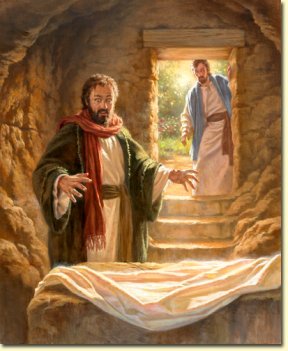 HEN MARY MADGALENE ARRIVES at the tomb and finds the stone rolled back, confusion falls upon her. She is so afflicted by the events of the last several days that she comes to mourn at Jesus’ tomb before the sun even rose.
HEN MARY MADGALENE ARRIVES at the tomb and finds the stone rolled back, confusion falls upon her. She is so afflicted by the events of the last several days that she comes to mourn at Jesus’ tomb before the sun even rose.  Seeing the tomb unsealed was very unexpected. What should she make of this scene? When she confronts Peter and the Beloved Disciple with the strange news, she says, “They have taken the Lord from the tomb, and we don’t know where they put Him.” Can you picture Mary Magdalene in this state of confused, grief-stricken hysteria? All she can say is, “What happened? Which way did He go?”
Seeing the tomb unsealed was very unexpected. What should she make of this scene? When she confronts Peter and the Beloved Disciple with the strange news, she says, “They have taken the Lord from the tomb, and we don’t know where they put Him.” Can you picture Mary Magdalene in this state of confused, grief-stricken hysteria? All she can say is, “What happened? Which way did He go?”
The experience is very different for the Beloved Disciple. He runs with great speed to the tomb, indicative not only of youthfulness but also of his anticipatory faith. When he arrives, the Beloved Disciple deferentially waits for Peter to go inside first. Notably, however, the Gospel tells us only that Peter “saw” the burials cloths folded and placed aside. Thereafter, we are subtly told that the Beloved Disciple “saw and believed.” Instantaneously, the sequence of events that confused Mary Magdalene and perplexed Peter are intuited. The Beloved Disciple does not get caught up wondering where Jesus has gone. He immediately thinks “of what is above, not of what is on earth.” He believes, on account of God’s gift and the evidence surrounding him, that “Christ is seated at the right hand of God.”
Shortly after this, the Apostles return home, leaving Mary Magdalene alone at the tomb. There, the Lord appears to her, and she becomes the first witness of the Resurrection. Before long, according to the Acts of the Apostles, Peter would be fearlessly traveling to “preach to the people and testify” that Jesus was “raised on the third day.” But it was the Beloved Disciple who first believed.
For this reason, the Beloved Disciple is a tremendous model of faith. In this Year of Faith, we are celebrating as a universal Church a virtue that has its origin in Easter Day. Were it not for the Paschal Mystery—the suffering, death, and ultimate Resurrection of our Lord—Christian faith would have no basis. The Letter to the Hebrews defines faith as “the substance of things to be hoped for, and the evidence of things not seen” (Hebrews 11:1). The coming to faith of the Beloved Disciple wasn’t merely the logical deduction of a sequence of events unexplainable by any other means. Surely another observer could have fabricated various explanations for what he and Peter and Mary Magdalene had seen. The coming to faith of the Beloved Disciple begins with his acceptance of what Jesus had revealed about Himself and ends with the Disciple’s interior illumination by grace.
That Jesus could die on the Cross and yet be raised from the dead is the definitive motive of credibility. For one who has faith, the state of confusion never lasts long. Mary Magdalene, who began that first Easter morning in utter confusion, declares this in the sequence for today’s feast: “Christ my hope is arisen. . . . Christ indeed from death is risen, our new life obtaining.” The Easter mystery serves as the bedrock for our faith, even as it did for the first disciples.
At the sight of our Savior’s rising, and formed by the virtue of faith, we dare to say: Alleluia!

